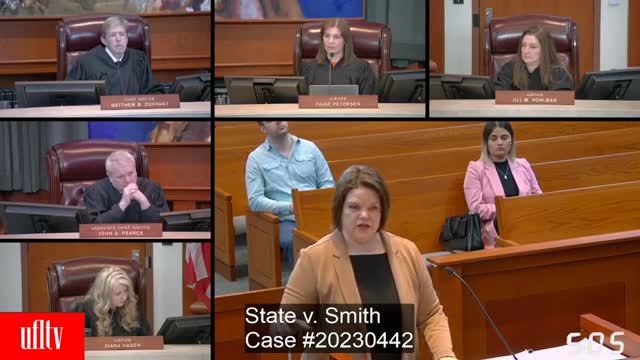Court hears arguments on statute of limitations in Jamieson Smith abuse case
May 21, 2025 | Utah Appellate Court Collection, Utah Family Law District Court Collection, Utah District Courts, Utah Judicial Branch, Utah
This article was created by AI summarizing key points discussed. AI makes mistakes, so for full details and context, please refer to the video of the full meeting. Please report any errors so we can fix them. Report an error »

In a pivotal oral argument held on April 9, 2025, the Utah Supreme Court examined the complexities surrounding the case of State v. Smith, which involves allegations of abuse dating back over three decades. The discussions highlighted significant legal questions about the burden of proof and the implications of the statute of limitations in prosecuting historical cases.
Central to the argument was the defense's assertion that the prosecution had not adequately demonstrated that a formal report of the alleged abuse had been made. The defense contended that the state bears the burden of proving that no report exists, especially given the lengthy time frame since the alleged incidents. This raises critical questions about how evidence is presented in cases involving claims from many years ago, where documentation may be scarce or nonexistent.
The court grappled with whether the victim's past statements, made during a school interview in the late 1980s, constituted sufficient evidence to establish that a report was made. The defense pointed out that while the victim recalled discussing the abuse, there was no clear indication that this conversation led to any formal action by law enforcement. This uncertainty complicates the prosecution's case, as it must prove that the statute of limitations has not expired, which is particularly challenging in cases involving events from decades past.
The justices also considered the implications of requiring the state to prove a negative—that no report was made—when the defense merely suggests that a report might exist. This aspect of the case underscores the difficulties faced by both sides in navigating the legal landscape of historical abuse allegations.
As the court deliberates, the outcome of this case could have far-reaching effects on how similar cases are handled in the future, particularly regarding the balance of proof and the treatment of evidence from long-ago incidents. The decision will not only impact the parties involved but also set a precedent for how the justice system addresses claims that arise many years after the alleged events. The community awaits the court's ruling, which will clarify the legal standards for prosecuting historical abuse cases in Utah.
Central to the argument was the defense's assertion that the prosecution had not adequately demonstrated that a formal report of the alleged abuse had been made. The defense contended that the state bears the burden of proving that no report exists, especially given the lengthy time frame since the alleged incidents. This raises critical questions about how evidence is presented in cases involving claims from many years ago, where documentation may be scarce or nonexistent.
The court grappled with whether the victim's past statements, made during a school interview in the late 1980s, constituted sufficient evidence to establish that a report was made. The defense pointed out that while the victim recalled discussing the abuse, there was no clear indication that this conversation led to any formal action by law enforcement. This uncertainty complicates the prosecution's case, as it must prove that the statute of limitations has not expired, which is particularly challenging in cases involving events from decades past.
The justices also considered the implications of requiring the state to prove a negative—that no report was made—when the defense merely suggests that a report might exist. This aspect of the case underscores the difficulties faced by both sides in navigating the legal landscape of historical abuse allegations.
As the court deliberates, the outcome of this case could have far-reaching effects on how similar cases are handled in the future, particularly regarding the balance of proof and the treatment of evidence from long-ago incidents. The decision will not only impact the parties involved but also set a precedent for how the justice system addresses claims that arise many years after the alleged events. The community awaits the court's ruling, which will clarify the legal standards for prosecuting historical abuse cases in Utah.
View full meeting
This article is based on a recent meeting—watch the full video and explore the complete transcript for deeper insights into the discussion.
View full meeting

